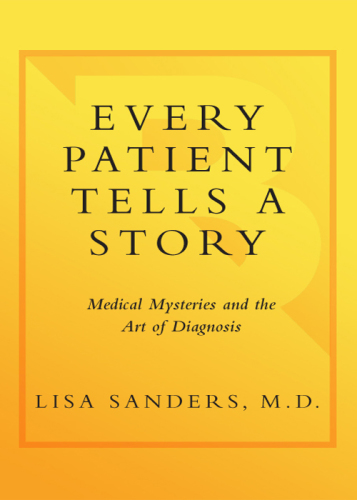
Every Patient Tells a Story
Medical Mysteries and the Art of Diagnosis
اسرار پزشکی و هنر تشخیص:
کتاب های مرتبط
- اطلاعات
- نقد و بررسی
- دیدگاه کاربران
نقد و بررسی

January 5, 2009
In her first book, internist and New York Times
columnist Sanders discusses how doctors deal with diagnostic dilemmas. Unlike Berton Roueché in his books of medical puzzles, Sanders not only collects difficult cases, she reflects on what each means for both patient and struggling physician. A man arrives at the hospital, delirious, his kidneys failing. Batteries of tests are unrevealing, but he quickly recovers after a resident extracts two quarts of urine. An abdominal exam would have detected the patient’s obstructed, grossly swollen bladder. The author then ponders the neglect of the physical exam, by today’s physicians, enamored with high-tech tests that sometimes reveal less than a simple exam. Another patient, frustrated at her doctor’s failure to diagnose her fever and rash, googles her symptoms and finds the correct answer. Sanders uses this case to explain how computers can help in diagnoses (Google is not bad, she says, but better programs exist). Readers who enjoy dramatic stories of doctors fighting disease will get their fill, and they will also encounter thoughtful essays on how doctors think and go about their work, and how they might do it better.

June 15, 2009
A doctor's insightful reflections on the disconnect between how physicians should practice and how they actually practice.
Although she is a consulting producer for the TV show House, Sanders (Medicine/Yale Univ. School of Medicine) admits that movie and TV doctors make diagnoses seemingly by magic or by uncovering a single overlooked clue. Real doctors listen carefully to patients and examine them, a procedure ignored in fiction but also by many of the current generation of doctors who often prefer tests and advanced technology."Ultimately," she writes,"the primary work of doctors is to treat pain and relieve suffering." Sanders tells the story of one patient who was feverish and clearly suffering from a severe infection, yet massive intravenous antibiotics weren't helping. A doctor noticed that one of the patient's toes looked gangrenous. When it was amputated, the infection vanished. Patients and doctors yearn intensely for a diagnosis—so intensely, in fact, that they may find one that doesn't actually exist. Writes Sanders:"Translating the big, various, complicated, contradictory story of the human being who is sick, into the spare, stripped down, skeletal language of the patient in the bed, and then making that narrative reveal its conclusion—that is the essence of diagnosis." The author also delves into Lyme disease, a tick-born infection that certainly exists but has given rise to a controversial movement in which a small group of patients suffering fatigue, pains, fever and general misery see a small group of doctors who diagnose a chronic Lyme infection that may require a lifetime of treatment. Studies cast doubt on the existence of this ailment, but both patients and doctors dismiss them, as they dismissed past skepticism of diseases such as the Epstein-Barr virus.
Fans of Jerome Groopman and Atul Gawande will appreciate this first collection by another astute observer of the medical profession.
(COPYRIGHT (2009) KIRKUS REVIEWS/NIELSEN BUSINESS MEDIA, INC. ALL RIGHTS RESERVED.)

Starred review from February 1, 2009
Sanders, a former journalist who is now a practicing internist and faculty member at Yale University's School of Medicine, writes a regular column for the "New York Times Magazine" featuring puzzling medical diagnoses. She has, however, a far wider audience as the inspiration and consulting producer for the Fox TV series "House". A collection of her "Times Magazine" columns, "Diagnosis" reads like a season of "House", minus quirky actor Hugh Laurie, but these accounts of anonymous patients with complicated symptoms and doctors demonstrating their diagnostic prowess are riveting nonetheless. Like heroes of detective fiction, the skilled physicians here bring a combination of exceptional knowledge, intuition, and occasional luck to solve mysteries and, often, save lives. Readers will enjoy the unfolding conundrums, but, perhaps more important, they will come away with a new appreciation for the enormous complexity of the human body and the doctors who face its challenges. Fascinating and skillfully written; highly recommended for health sciences and public libraries. [See Prepub Alert, "LJ" 10/1/08.]Kathy Arsenault, Univ. of South Florida at St. Petersburg Lib.
Copyright 2009 Library Journal, LLC Used with permission.

April 1, 2009
New York Times columnist Sanders says that misdiagnoses account for perhaps as much as 17 percent of medical errors. Some errors result in prolonged or ineffective treatment, while others lead to fatal outcomes. They occur, she says, despite the huge technological advances of recent years. Sometimes the tests and diagnostic tools are to blame; indeed, relying too heavily on test or lab results can produce a false sense of security in both patient and doctor. For all the data they collect, machines lack important components for diagnosis. They cannot hear a patients story, touch a patients skin, or look into a patients eyes. Good diagnosticians arenot unlike TVs Dr. Housegood at puzzles; they employ a large variety of skill sets, including the long-lost art of the thorough physical exam, to solve the mysteries of illness. Besides her own inborn capacity for problem-solving, Sanders experience as internist, writer, and consultant to House serves her well here, for absorbing anecdotes generously pepper the exposition.(Reprinted with permission of Booklist, copyright 2009, American Library Association.)

























دیدگاه کاربران